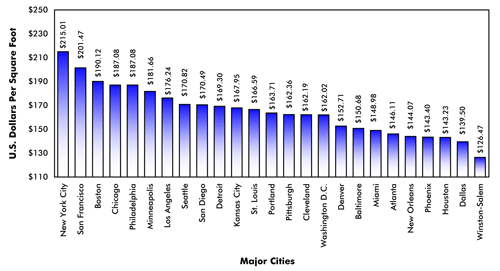A short time ago, I was given the opportunity to visit the manufacturing facility and headquarters of Weil Pump Company. While I’d visited manufacturing facilities in the past, the home-built processes and workflows at Weil stood out.
First, the company is located in picturesque Cedarburg, Wisconsin. Having never visited Wisconsin, I was unsure what to expect. What I found in Cedarburg was a cozy town just a short distance from the shore of Lake Michigan. The town center consisted of mostly boutique craft, jewelry, and sweets shops mixed with bars, restaurants and breweries. Charming homes built in the Victorian style surrounded, and a wide creeek flowed through town, including a waterfall. Iron and stone bridges connected either side of the town, and a park with lush green grass and cattails, amphitheater and playground, and at night, fireflies was located to the south end of the main street in town. Late into the evenings, the town stayed active with couples strolling and children roaming in packs. As one of my travel companions and guide aptly assessed, it felt like stepping back in time about fifty years.

Such an ideally small-town American setting is home to a company whose methods remain focused on robust, American quality through a hands-on approach. Weil Pump Co makes pumps for a variety of applications, including commercial construction, industrial facilities, and water treatment. They have a reputation of being a somewhat higher-shelf, though lasting, product. On the tour, I found out what goes into that distinction.
Weil currently occupies a factory formerly belonging to US Motors. Their employees seemed tight-knit and they operate a single shift, though they have capacity to more than double their staff. After learning about Weil Pump Co’s decades-long history, we began in the control panel construction portion of the facility. There, a handful of employees hand-assembled the components of the control panels used to monitor and control pumps. From bins, employees pulled components including shut-off switches, warning lights, computer boards, pump cycle switches, etc. At Weil, each panel is built by hand, and all its functions tested for every order. And the employees who build them were more than cordial and eager to show us what they did each day. Weil also provides a space for two computer science oriented employees who develop the layout and programming for their panels. They walked us through their newest endeavor – a touch-screen control panel with a complimentary app for smartphones or desktops to help facility management professionals monitor and control the operation of their pumps remotely.
Next, we visited the portion of the facility where pumps are assembled. Casings – the pump body – are brought in on palettes. Like the control panels, Weil pumps are assembled by hand at various stations throughout the facility. At one station, seals were pressed and pressure tested. At another, wires were installed and made water proof. At another workstation, windings – a component of the motor – were sealed in resin and tested for continuity. Weil includes a number of distinct assembly procedures in their process, including double sealed bearings held in place with spring tension and a recently-developed means of suppressing moisture wicking through electrical wire insulation. An important station was impeller balancing. Impellers are the “blades” that pull fluids through the pump. Each Weil impeller is balanced by hand. That is, one employee tests each assembled impeller-pump shaft assembly on a computerized turn-table and removes material as required, using a hand grinder, until the impeller balance is within allowable tolerances. This is akin to adding a weight to your ceiling fan blades until it spins smoothly.

Perhaps the most interesting part of the assembly facility was the portion dedicated to testing and troubleshooting. Impressively, each pump that’s made at Weil is hand tested by one employee in a custom-built tank. The flow rate and pressure produced by each pump is recorded in a log before it’s removed from the tank, cleaned, and then shipped to the customer. If a pump doesn’t meet the minimum requirements that it’s designed to, it’s deconstructed. Weil also takes a keen interest in troubleshooting problems with pumps that have seen failures in the field. In one portion of their facility, pumps that had seen operation and stopped working were deconstructed, piece-by-piece, and evaluated. Weil keeps notes of the pump’s installation, location, and what liquid it was pumping. Their purpose for this meticulous (and messy) job is to gain feedback on their product and improve where possible.
Weil also manufactures a number of accessories for their pumps, including basins, removal systems, and duplex valve assemblies. Like their pumps, all are extremely robust (sometimes perhaps exceedingly), as well as hand-assembled. Each product that leaves the factory was packaged up, then individually inspected and signed-off on by one of Weil’s directors.
Disconnected from the assembly facility was the machining facility. There, about 20 CNC (computer numerical control) machines followed programming developed in-house using Solid Works to widdle and machine brass, cast iron and other metals into the casings, rods, impellers, and other parts used in Weil Pumps. It was a fast paced, and noisy environment, though also clean and organized. We visited with the Solid Works operator who showed us his CNC plans, and the path the machine would take over a cube of cast iron, slowly removing material until a pump-body took shape.
I’ve never seen an operation like Weil’s, where nearly everything was made and assembled in-house. Most facilities I’ve visited import components, many of which were pre-assembled, and then add finishing touches. While Weil does outsource some components, such as a seals and bearings, the great majority of their product is made in Cedarburg. Many of their employees had also worked there for decades and had been instrumental in the development of the products they sell. Like the town of Cedarburg itself, visiting Weil Pump Co felt like a step back to an ideal time when “Made in America” was common place, as well as synonymous craftsmanship, ingenuity, and quality.
And as I was told, no trip to Cedarburg was complete without trying one’s luck on Lake Michigan. For that, we were guided by Dan Fox, who like Weil Pump, has crafted and run a Cedarburg enterprise for decades. As Weil’s experience has taught them how to build a top-of-line pumps, Captain Fox’s 42 years of experience taught him all the variables required for a special catch.





